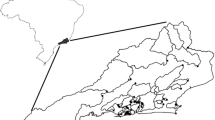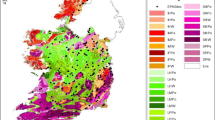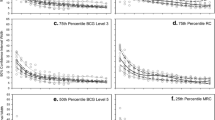Abstract
Human induced increases to nutrientconcentrations in streams have led to many agenciesdeveloping strategies and criteria for nutrientreduction. National or statewide guidelines aregenerally inappropriate, due to the natural variabilityin stream ecosystems within political boundaries. Thisstudy used an extant aquatic macroinvertebrate-basedregionalisation for the state of Victoria, Australia, asthe basis for defining regions of relatively homogeneousenvironmental character. This enabled the selection ofecologically-based regional reference sites andsubsequent characterisation of the nutrient status ofthese sites. Using an extensive biological and nutrientdata base for streams across the State, we calculated50th and 75th percentile concentrations forreference sites within each region. Using thesepercentiles in conjunction with ‘impact and recovery’studies, we defined nutrient guidelines for each region. Although the nutrient data largely supported thebiological regionalisation, patterns in the nutrient datadid require some minor modifications for the nutrientregions. Relatively unimpacted regions with referencesites in very good-to excellent-condition were assignedguidelines largely based on the 75th percentiles. The more impacted regions, where ‘best available’reference sites were of poorer quality, were assignedguidelines based largely on the 50th percentiles. Professional judgement and known extents of impactsacross each region provided important contributions tothe decision-making process. The derived guidelineconcentrations are comparable to several cited in theliterature and are proposed for use in monitoring,assessment and restoration targets.
Similar content being viewed by others
References
Alcocer, J. and Escobar, E.: 1996, ‘Limnological regionalization of Mexico’, Lakes and Reserv. 2, 55–69.
Anderson, J. and Morison, A.: 1989, Environmental Flow Studies for the Wimmera River, Victoria: Part D. Fish Populations, Past Present and Future. Conclusions and Recommendations, Arthur Rylah Institute for Environmental Research, Technical Report Series No. 76, Conservation, Forests and Lands, Victoria.
ANZECC: 1992, Australian Water Quality Guidelines for Fresh and Marine Waters, Australian and New Zealand Environment and Conservation Council, Canberra Australia.
Bailey, R.: 1976, Ecoregions of the United States, United States Department of Agriculture, Forest Service, Intermontaine Region, Ogden, Utah.
Chessman, B.: 1995, ‘Rapid assessment of rivers using macroinvertebrates: A procedure based on habitat-specific sampling, family level identification and a biotic index’, Aust. J. Ecol. 20, 122–129.
Cottingham, P., Bennison, G., Dunn, R., Lidson, J. and Robinson, D.: 1995, Algal Bloom and Nutrient Status of Victorian Inland Waters, Department of Conservation and Natural Resources.
Cullen, P.: 1983, ‘Sewage effluent disposal in the Crackenback River – The assimilation capacity of an upland stream’, Report to Kosciusko Thredbo Pty. Ltd., Canberra, Australia.
Davies, P.: 1994, River bioassessment manual, National River Processes and Management Program, Monitoring River Health Initiative. Commonwealth Environment Protection Agency, Land and Water Research and Development Corporation and the Department of Environment, Sport and Territories, Canberra, Australia.
Dodds, W. K.: 1993, ‘What controls levels of dissolved phosphate and ammonium in surface waters?’, Aquat. Sci. 55, 132–142.
Dodds, W., Jones, J. and Welch, E.: 1998, ‘Suggested classification of stream trophic state: Distributions of temperate stream types by chlorophyll, total nitrogen and phosphorus’, Wat. Res. 32, 1455–1462.
Dodds, W. K., Smith, V. H. and Zander, B.: 1997, ‘Developing nutrient targets to control benthic chlorophyll levels in streams: A case study of the Clark Fork River’, Wat. Res. 31, 1738–1750.
Dodds, W. K. and Welch, E. B.: 2000, ‘Establishing nutrient criteria in streams’, J. N. Am. Benthol. Soc. 19, 186–196.
Duncan, J.: 1982, ‘Relief’, in J. Duncan (ed.), Atlas of Victoria, Victorian Government Printing Office, Melbourne, Victoria, Australia. pp. 3–5.
Goudey, R.: 1999, Assessing Water Quality Objectives: Discussion Paper, Environment Protection Authority, Melbourne, Victoria, Australia.
Government of Victoria: 1999, State Environment Protection Policy (Waters of Victoria): Schedule F7 (Waters of the Yarra catchment), Environment Protection Authority (EPA), Melbourne, Victoria, Australia.
Hart, B. T., Maher, B. and Lawrence, I.: 1999, ‘New generation water quality guidelines for ecosystem protection’, Freshw. Biol. 41, 347–359.
Hughes, R. M.: 1995, ‘Defining Acceptable Biological Status by Comparing with Reference Condition’, in W. Davis and T. Simon (eds), Biological Assessment and Criteria. Tools for Water Resource Planning and Decision Making, Lewis Publishers, Boca Raton, Florida, pp. 31–48.
Hunter, K.: 1993, ‘Victorian Water Quality Monitoring Network, August 1990–December 1992’, Report No. 110, State Water Laboratory of Victoria, Mount Waverley, Victoria, Australia.
Hunter, K. and Hedger, M.: 1995, ‘Victorian Water Quality Monitoring Network Annual Report 1994’, Report No. 29/95, Department of Conservation and Natural Resources, Melbourne, Victoria, Australia.
Hunter, K. and Loone, J,: 1996, ‘State Water Quality Monitoring Annual Report: Victoria 1995’, Report No. 70/96, Department of Natural Resources and Environment, Melbourne, Victoria, Australia.
Hunter, K. and Zampatti, B.: 1994, ‘Victorian Water Quality Monitoring Network Annual Report 1993’, Report No. 112, State Water Laboratory of Victoria, Mount Waverley, Victoria, Australia.
Jenkin, J.: 1982, ‘Physiography’, in J. Duncan (ed.), Atlas of Victoria, Victorian Government Printing Office, Melbourne, Victoria, Australia, pp. 20–25.
Larsen, D. P., Dudley, D. R. and Hughes, R. M.: 1988, ‘A regional approach for assessing attainable surface water quality: An Ohio case study’, J. Soil and Wat. Cons. 43, 171–176.
McKay, J.: 1982, ‘Population’, in J. Duncan (ed.), Atlas of Victoria, Victorian Government Printing Office, Melbourne, Victoria, Australia. pp. 82–88.
Metzeling, L.: 1987, ‘The Response of the Macroinvertebrate Fauna in the Wimmera River to a Special Release of Water’, Rural Water Commission, Victorian Report No. WQ13, Rural Water Commission, Victoria.
Metzeling, L., McKenzie, F. and St. Clair, R.: 1996, ‘The effects of fish farming on the water quality and invertebrate fauna of two upland streams’, Publication No. 482, Environment Protection Agency Authority (EPA), Melbourne, Victoria, Australia.
Metzeling, L., Newall, P. and Croome, R.: 1993, Biological Monitoring of the Invertebrates, Phytoplankton and Diatoms of the Wimmera River, Publication No. SRS90/019, Environment Protection Authority (EPA), Melbourne, Victoria, Australia.
Miltner, R. and Rankin, E.: 1998, ‘Primary nutrients and the biotic integrity of rivers’, Freshw. Biol. 40, 145–158.
Minitab Inc.: 1997, MINITAB User's Guide 2: Data Analysis and Quality Tools: Release 12 for Windows, Minitab Inc., State College, Pennsylvania. Chapter 1, pp. 17–21.
Morley, R., Newall, P. and Bennison, G.: 1989, ‘The biology and chemistry of selected Mt. Stirling sub-alpine streams (Survey and Monitoring 1986–1988)’, Report No. 100, Rural Water Commission, Victoria, Australia.
Newall, P. and Wells, F.: 2000, ‘The potential for delineating indicator-defined regions for streams in Victoria, Australia’, J. N. Am. Benthol. Soc.
OECD: 1982, Eutrophication of Waters: Monitoring, Assessment and Control, Organisation for Economic Co-operation and Development, Paris, France, 154 pp.
Omernik, J. M.: 1987, ‘Ecoregions of the conterminous United States’, Ann. Assoc. Am. Geog. 77, 118–125.
Omernik, J. M., Larsen, D. P., Rohm, C. M. and Clarke, S. E.: 1988, ‘Summer total phosphorus in lakes: A map of Minnesota, Wisconsin and Michigan, U.S.A.’, Env. Manag. 12, 815–825.
Paine, D.: 1982, ‘Vegetation’, in J. Duncan (ed.), Atlas of Victoria, Victorian Government Printing Office, Melbourne, Victoria, Australia, pp. 49–56.
Reynoldson, T. B., Norris, R. H., Resh, V. H., Day K. E. and Rosenberg, D. M.: 1997, ‘The reference condition: A comparison of multimetric and multivariate approaches to assess water-quality impairment using benthic macroinvertebrates’, J. N. Am. Benthol. Soc. 16, 833–852.
Ryding, S.-O. and Rast, W.: 1989. The Control of Eutrophication of Lakes and Reservoirs, UNESCO and The Parthenon Publishing Group, Paris, France.
Simpson, J., Norris, R., Barmuta, L. and Blackman, P.: 1997, ‘Australian river assessment system (AUSRIVAS)’, National river health program predictive model manual, http://AUSRIVAS.canberra.au/AUSRIVAS
Tiller, D.: 1988, ‘Impact of sewage effluent on the benthic macroinvertebrate community of the upper Thredbo River’, Unpublished Masters Thesis, Faculty of Applied Science, University of Canberra, Canberra, Australia.
Tiller, D.: 1993, A Preliminary Study of the Effects of Victorian Alpine Ski Resorts on High Mountain Streams, Publication No. SRS90/010. Environment Protection Authority (EPA), Melbourne, Victoria, Australia.
Tiller, D. and Newall, P.: 1995, Preliminary Nutrient Guidelines for Victorian Inland Streams, Publication No. 478, Environment Protection Authority (EPA), Melbourne, Victoria, Australia.
USEPA: 1998, National Strategy for the Development of Regional Nutrient Criteria, EPA 822-R-98-002, United States Environmental Protection Agency, Washington, D.C.
Warry, N. D. and Hanau, M.: 1993, ‘The use of terrestrial ecoregions as a regional-scale screen for selecting representative reference sites for water quality monitoring’, Env. Manag. 17, 267–276.
Wells, F., Metzeling, L. and Newall, P.: (submitted), ‘A statewide regionalisation of streams using aquatic macroinvertebrates’.
Author information
Authors and Affiliations
Corresponding author
Rights and permissions
About this article
Cite this article
Newall, P., Tiller, D. Derivation of Nutrient Guidelines for Streams in Victoria, Australia. Environ Monit Assess 74, 85–103 (2002). https://doi.org/10.1023/A:1013806805798
Issue Date:
DOI: https://doi.org/10.1023/A:1013806805798




